Urology
In the Urology Clinic of Istanbul Surgery Hospital, where special treatment methods are applied for each age group in urological diseases and a multidisciplinary approach is adopted; There are solutions for the diagnosis and treatment of all diseases such as kidney and urinary tract stone diseases, prostate diseases, urological cancers, urinary incontinence problems by specialist physicians.
Men’s Health Polyclinic
In the polyclinic, endocrine and metabolic evaluations and cardiological treatment methods, when necessary, are treated by specialist physicians with a multidisciplinary approach in diseases such as prostate health, premature ejaculation, erectile dysfunction, erection problems, penile curvature and prosthesis, male aging health, which pose a risk to men’s health.
Stone Diseases Polyclinic
Hard masses with mineral content formed in the kidney canals are called kidney stones. The mechanism of formation of kidney stones, which is very common in the community, is unknown. However, genetic predisposition is an important factor in stone formation. Kidney stones, which are three times more common in men than in women, are treated by closed endoscopic surgeries in the Urology Clinic of Istanbul Surgery Hospital.
Closed Ureter Diagnostic Treatment – Ureterolithotripsy (URS)
URS is known as the treatment method for urinary tract stones between the kidney and the bladder. In surgeries performed under general or spinal anesthesia in the operating room environment, the stone is removed from the body by first entering the bladder and then the ureter with instruments called “ureterorenoscope” without any incision. The patient can return to his normal life within a day after the operation.
Endoscopic Kidney Diagnostic Treatment – Percutaneous Nephrolithotomy (PCNL)
PCNL is generally used in the treatment of kidney stones of 2 cm or more. A piece of tube is inserted from the skin to the kidney with the help of a special set of instruments through an incision of one cm at the level of the kidney. With the help of an optical device, the stone in the kidney is seen on the monitor with the video system. With the help of laser, the stone is broken and taken out of the body with the help of forceps. In this method, which has a very fast recovery period compared to open kidney surgeries, the patient can perform his daily activities in a short time like two days.
Flexible Ureterorenoscopic Lithotripsy
It is a form of treatment used for stones that cannot be reached with a normal ureterorenoscope. In this treatment method, which is performed under general anesthesia and operating room conditions, stones are removed by entering the bladder and then the kidney with special bendable instruments without cutting or puncturing any part. After the operation, the patient can be discharged within a day and return to his daily life.
Urinary Incontinence Polyclinic
Urinary incontinence in men and women is treated with outpatient surgical methods. For the diagnosis of urinary incontinence disorders, urine flow rate measurement, urodynamic evaluation, postvoid residual measurement are performed. In addition to medical and behavioral treatment, surgical procedures such as botox treatment, application of injection material to the bladder neck can also be applied to the patients. In the surgical treatment of urinary incontinence, TOT, TVT, pubovaginal sling, cystocele, rectocele repair and artificial sphinter insertion operations can be performed in the clinic.
Male Reproductive Health Clinic (Infertility, Infertility)
Anatomical and functional evaluations of male reproductive organs; Ultrasonography is performed with hormone analysis. In the clinic, chromosomal and genetic evaluations are performed in patients deemed necessary. All infertility operations such as microscopic varicocelectomy, TUR-ED, epididymovasostomy, vasectomy are performed surgically.
Prostate Diseases
Prostate diseases are one of the most common diseases in men. Prostate enlargement is usually seen as a “benign tumor” growth. Symptoms such as difficulty urinating and frequent urination are observed in patients. It is recommended that men with a family history of prostate disease should have regular PSA tests after the age of 50. After the diagnosis is made, the treatment is decided according to the degree of the disease. Patients are usually followed up with medication. When surgical intervention is required, surgery is performed by the Urology Physicians of Istanbul Surgical Hospital with the “TUR-P method”.
Urological Cancers
Familial predisposition has an important place in the occurrence of kidney, prostate and bladder cancers. It is recommended that people with a family history of these types of cancer should have regular check-ups. After the diagnosis, according to the type of cancer, he is treated with laparoscopic or open surgeries in the Urology Clinic of Istanbul Surgery Hospital.
Varicocele (Vascular Enlargement)
Varicocele is defined as a kind of vasodilation that occurs in the veins returning from the testicles to the heart in men. Varicocele is seen in 25-30 percent of men with infertility problems. Varicocele diagnosed by physical examination is treated surgically. In the clinic, the treatment of the patient is provided by ligating the veins coming from the testis with the operation performed in the inguinal region under the visual or microscope guidance.
Pediatric Urology
The clinic, which treats the respiratory, digestive and excretory systems from the neonatal period to adulthood (0-17 years of age), is cared for by specialist physicians in the field of child development, physiology and psychology.
In the Clinic, where modern treatment methods are adopted,
- Neonatal Surgical Diseases,
- Surgical Diseases of the Excretory System and Reproductive Organs,
- Surgical Diseases of the Digestive System,- Surgical Diseases of the Respiratory System are treated with a multidisciplinary approach.
Circumcision
Circumcision, which can be performed at any age from birth, is performed by specialist surgeons in Istanbul Surgery Hospital Urology Clinic, in operating room conditions, in accordance with surgical principles.
Laparoscopic and Robot-assisted prostate cancer surgery
Prostate cancer is located only in the prostate in some patients. These patients can be treated and full cure can be achieved. Unfortunately, in some of our patients, the disease may have spread throughout the body, and complete healing cannot be achieved. Prostate cancer is resistant to chemotherapy but sensitive to radiotherapy. For cancer confined to the prostate, therefore, the best option is to surgically remove the entire prostate. Then the urethra and the urinary bladder (bladder) are connected to each other.
There are various surgical methods applied today. These are open, closed laparoscopic and Robot-assisted laparoscopic methods. Robot-assisted or unaided laparoscopic surgery is preferred worldwide. Here, the prostate is completely removed and the opening that occurs after the prostate comes out is closed by suturing the urinary canal with the bladder, and a new channel is created through which the urine can flow easily.
If we briefly summarize the process;
4 short pipes with a diameter of 1 cm, called tokars, are applied to the abdomen, one camera is used from the other 3 trocars, and a robotic surgical instrument or laparoscopic instrument that allows the surgeon to operate is used. These four thin instruments are placed inside the patient’s abdomen and the operation is started. After the prostate is taken out together with the sperm bags and the lymph node, which is at risk of spreading, is removed, the urinary canal and the urinary bladder are connected to each other. Permanent catheter is applied, it is usually removed after 5 days depending on the recovery status.
“Prostate cancer is a disease with increasing treatment success and importance. Prostate cancer is the 5th most commonly diagnosed cancer type in the world. ”
Cause of Prostate Cancer
The cause of prostate cancer is unknown, but the older you get, the greater your risk of developing prostate cancer. If the number of men in your close family who have prostate cancer is high, you have a higher risk of developing the disease. It is not contagious and does not pass from person to person. The most important factor that increases the risk of developing prostate cancer is age. It is the most important risk factor for prostate cancer. It is rare under 45 years of age. The risk increases as you get older.
Family history is also effective in the risk of developing prostate cancer. The risk is increased in those whose brothers have had prostate cancer. Race is known to be important in prostate cancer. It is more common in African Americans than whites. Those with cells with high-grade prostatic intraepithelial neoplasia in their previous biopsies have an increased risk of prostate cancer. These cells appear abnormal under the microscope. Eating foods rich in animal fat and containing meat has been shown to increase the risk of prostate cancer in some studies.
What is MR Fusion Prostate Biopsy?
It is a biopsy application for the target area with MR imaging for the accurate and definitive diagnosis of suspicious tumor foci. Biopsy can be performed with the help of a special needle for the foci with suspected cancer in the prostate. It was developed for the purpose of accurate diagnosis and to prevent repetitive biopsies.
Why is a prostate biopsy done?
- It is the only known method for definitive diagnosis of prostate cancer.
- Sampling is performed with minimal deviation and error from areas with tumor risk.
- The gold standard is diagnosis.
- It reduces the need for repeat biopsy.
- It is a short process.
- It is a painless procedure as painkillers are given.
- The pathology result comes out in a few days.
- After the procedure, the patient does not need to stay in the hospital.
As with most types of cancer, early diagnosis is life-saving in prostate cancer. With the help of special needles, an average of 12 samples are taken from the prostate and the samples are sent to pathology specialists for analysis. The number of samples taken varies depending on the suspicious lesion and prostate volume determined in MRI.
The purpose of prostate biopsy is to evaluate the tissue samples taken for cancer. Rectal examination, MR, PSA, PCA3, PSA PHI, SelectMDx tests performed before the procedure do not replace rectal biopsy, they only determine whether the biopsy should be performed or not.
How is MR Fusion Prostate Biopsy Performed?
In order to obtain the most accurate biopsy result, ultrasound image and MR image are combined with the help of special software and a single image is obtained. In this way, it is possible to perform a biopsy in a point sense.
Prostate biopsy can be performed without anesthesia.
We recommend that the procedure be performed with sedation (as in gastric endoscopy) to make you comfortable.
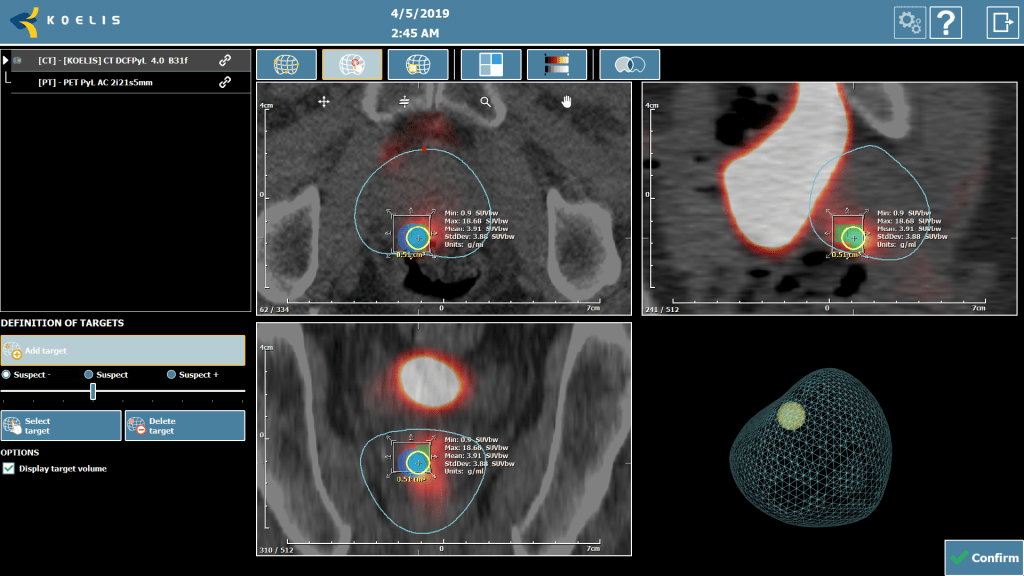
MR/PET/PET-CT images taken from the patient are loaded into the device. Suspicious areas/lesions are marked on the 3D images taken.
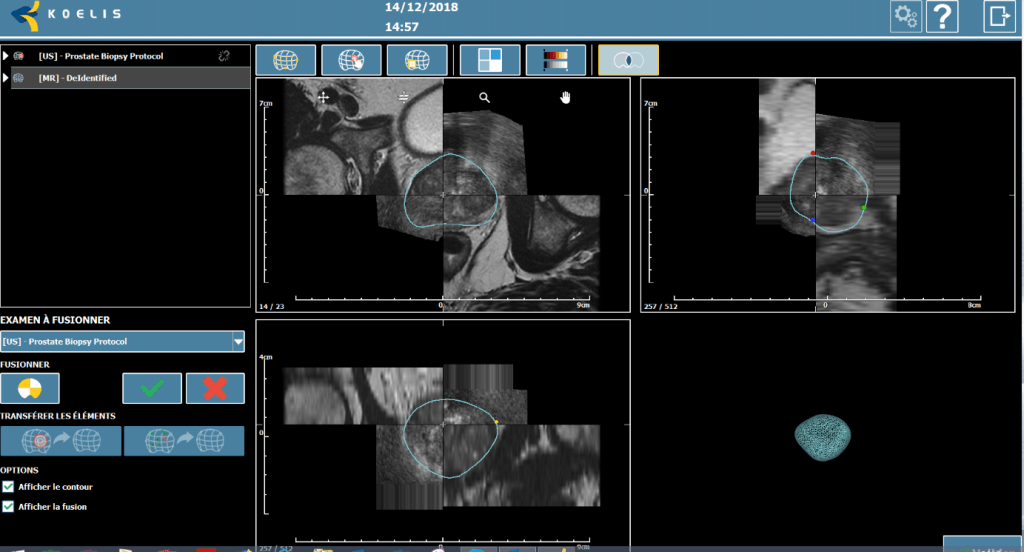
Elastic Fusion technology not only combines the ultrasound image and the MR image by superimposing it, but also continues active fusion by sensing the deformation of the prostate in case the patient moves. In this way, it allows planning before taking samples from the desired area. Minimizes the risk of infection with less needle insertion combined with planning
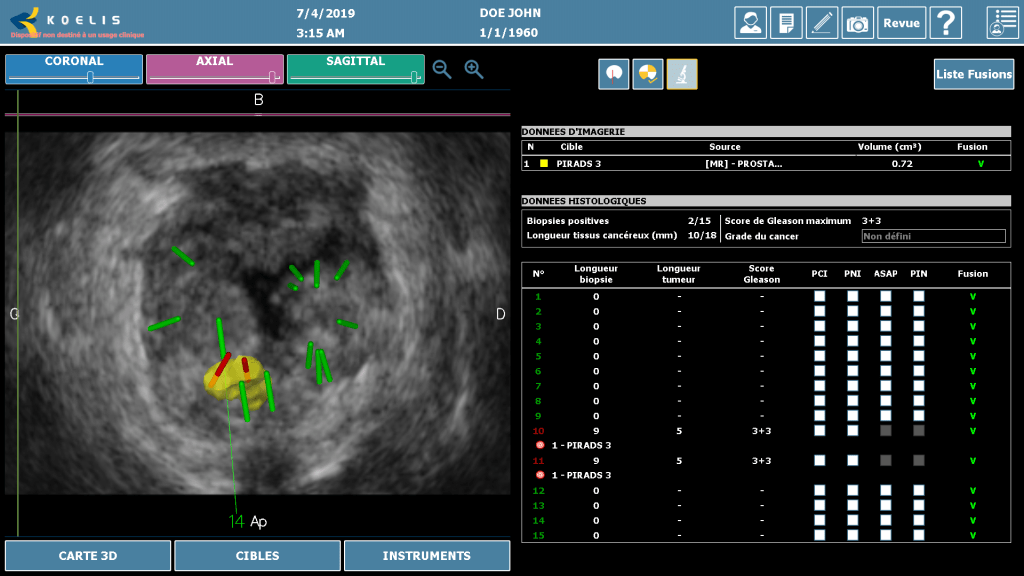
The results from the pathology are recorded on the device to the relevant patient. The fusion biopsy that has been performed can be referenced for the next biopsy. Or if treatment is planned for the patient, treatment planning can be done.
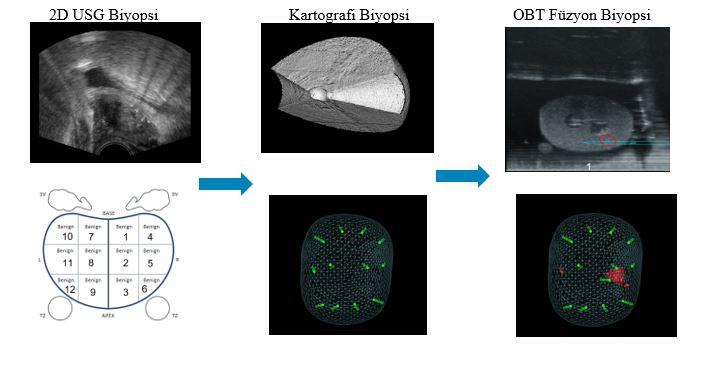
Organ-Based Tracking Fusion® (organ tracking) is a patented KOELIS innovation that works in harmony with elastic fusion technology. Unlike other technologies that monitor the movement of the probe, it monitors the changing prostate and automatically compensates for its movements. It therefore maximizes the accuracy of the procedure. With this personalized method, it provides controlled monitoring of the patient. The Trinity® prostate fusion biopsy system is the only system in the world equipped with this technology.
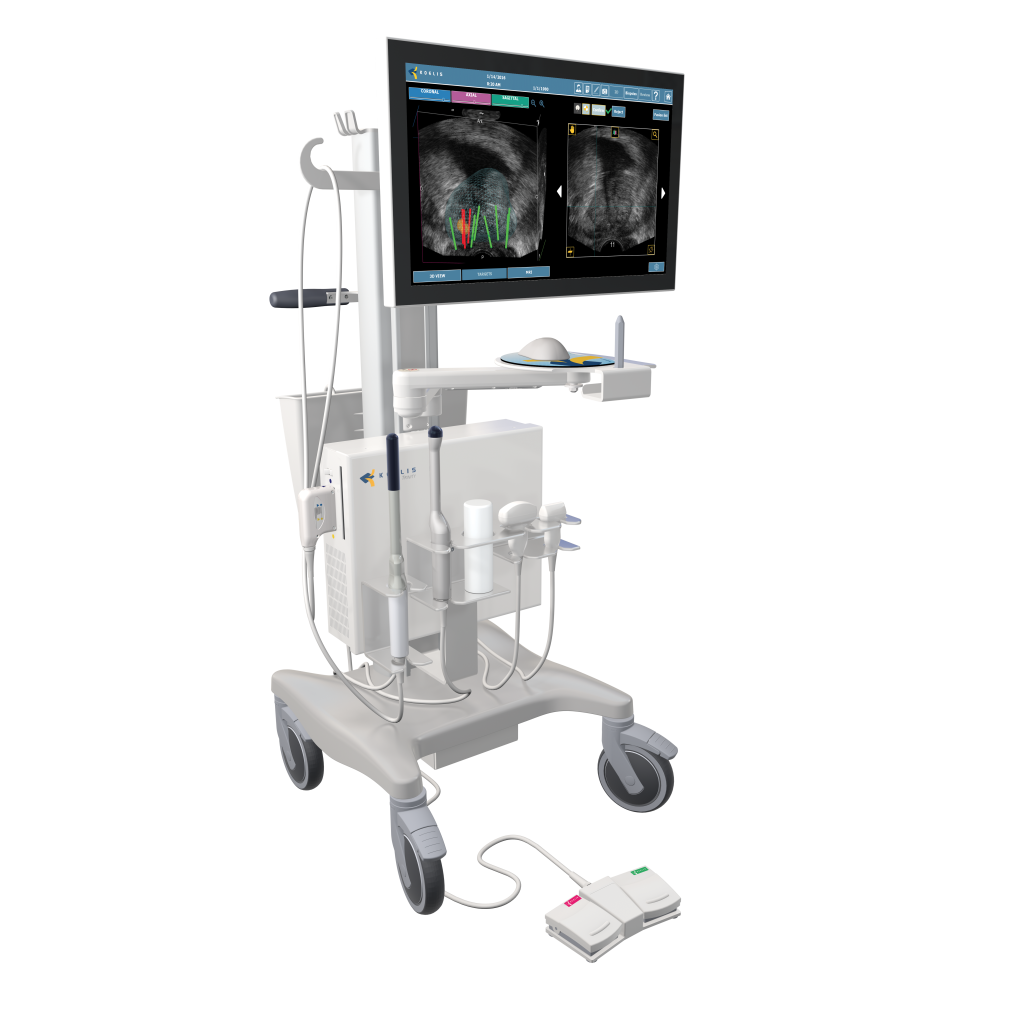
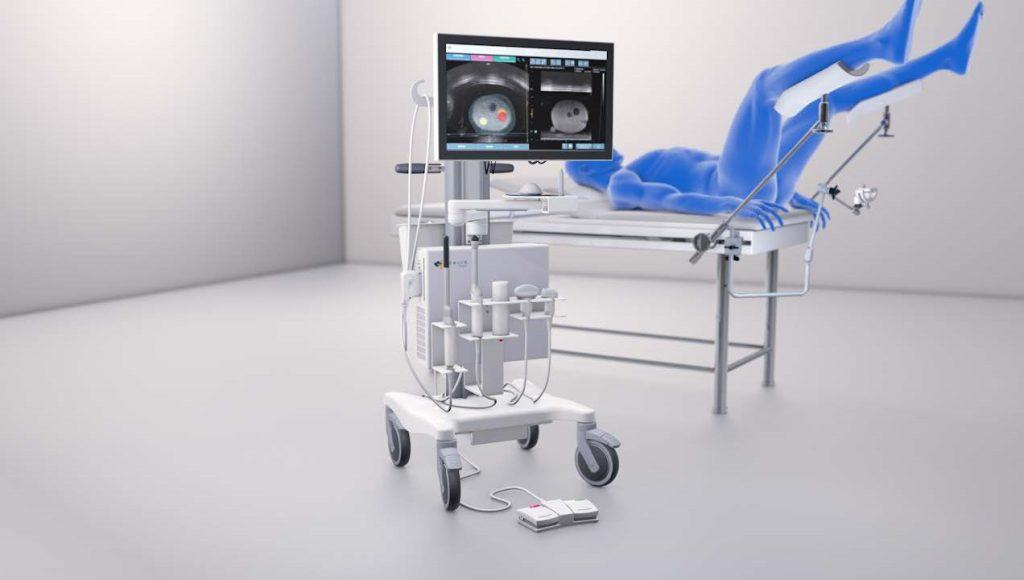
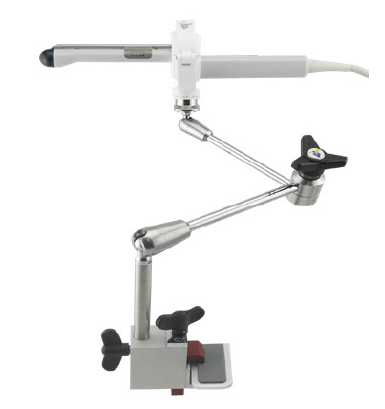
The Koelis Trinity 3D Trus MR-Fusion Prostate Biopsy System in our hospital combines the US/MR image with the tracking of elastic fusion and Organ-Based Tracking technology into a single image. With its easy-to-use platform, it provides physicians with a sensitive and high-quality control in prostate biopsy application and offers individual answers for each patient. The 3D Prostate Package includes Promap-US, Promap-MR and Promap-2L.



